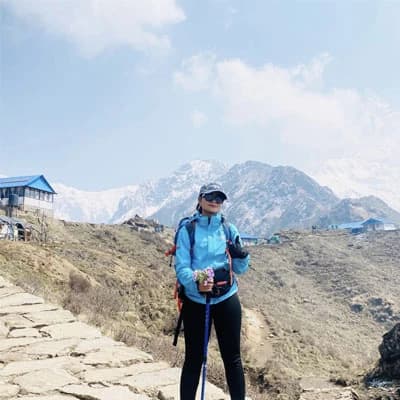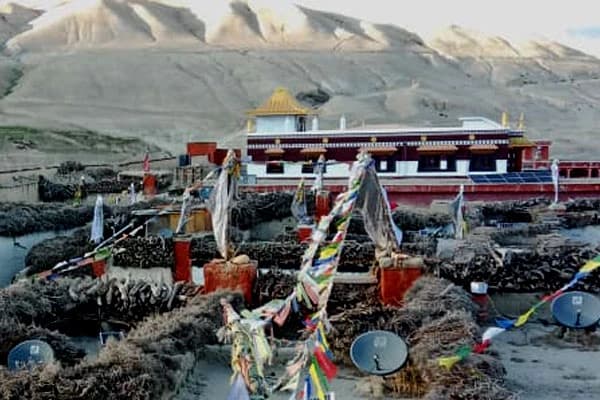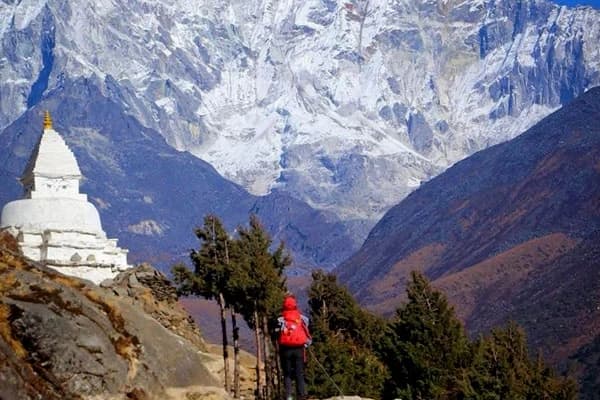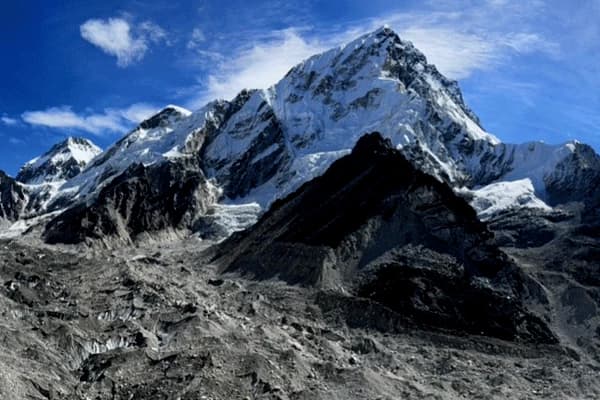Is it possible to trek in Langtang solo in 2025 and 2026?
Even though trekking to Langtang Valley solo was possible before, since 2025, the new regulation initiated by the NTB (Nepal Tourism Board), with the support of the Government of Nepal, has clearly stated that, to hire an experienced licensed trekking guide through an agency, which supports the fact that the trip to Langtang without a guide is impossible. Two permits are required for this trip: firstly, the Langtang National Park Permit and secondly, the TIMS Card (Trekkers Information Management System Card), which can only be granted by the locally-based trekking agency. Hence, there is no way that you can skip these mandatory rules and hike independently without the assistance of the guide.
The main motive of such mandatory regulations is for the safety of the travellers, especially tourists, who are unaware of such a region, to preserve nature in their pristine conditions, boost the local economy and for cultural preservation. Despite being considered a safe adventure, the Langtang region possesses many dangers, while hiking alone, such as the possibility of getting lost in the woodland, as there are no navigation marks at many points, losing track, with the possibility of encountering wildlife, coming across some landslide prone areas, and getting injured, along with the weather uncertainty, high risk of AMS (Acute Mountain Sickness), and a remote trailhead, that makes the condition, more fragile to underatake the Langtang solo trek.
On the other hand, being at such a high-elevation Himalayan adventure, many of the days go by without any network, whereas, if planned the trek at peak seasons, the major problem that you will come across is not getting any rooms at the tea houses, as they are full booked, by the agencies, beforehand, where the lodges follow, "First come, First get policies", so settling in for the night, becomes, a huge hassle, on the route. Meanwhile, the major issue that independent hikers must face is communicating with locals, as many people there either speak their dialect language of Nepalese dialect (the mother tongue language), which makes everything even more complicated.
Meanwhile, on the good note, "Solo Trekking is still Possible", following every guideline and regulation of the government, however, with three possibilities only. Firstly, either join a small group or fixed departure dates, so you can navigate along with a trekking guide, without any issue. Secondly, if you still want to trek alone, without any group joining and craft the itinerary, as per your wish and estimated cost, then hire a registered, experienced local guide to assist you, who can help to get permits, follow rules, and also, make the trek, safe with an insightful informative overview, of the region, mountains, landscapes, and the cultural roots of the locals, in depth.
Along with that, having a guide beside you stands out to not only be logistical support, but also an emergency support, for minor injuries, and quick response for the medical rescue, if any unfortunate situations occur along the route, providing safety, and a hassle-free journey, where you can travel peacefully. Thus, no matter whether you hike along with a guide or are willing to travel all the way, along, the success factor demands your preparedness; however, hiring a guide contributes 90% to the successful and insightful odyssey.
What are the Major Perks of Trekking in Langtang Valley Solo (with a Guide)?
Freedom to your Choice and Pace
Venturing out on a solo trip to Langtang Valley, with the guide you have hired, offers flexibility and freedom to choose the stopping points. navigation route, and also plan the whole day, as per your wish, without being influenced by others. While on a group trip, you need to be concerned 24 hours, with how well your group is coping, or how you can relatively, cope up with, even when you are tired, which puts the overall journey in a complete panic mode.
At the same time, trekking means just pacing on your own, feeling the nature, and serenity far from the crowd mass, where being in the group, what's the point of hiking, when your 1 guide supports the whole group, only a rapid pace, where you couldn't even get a good snap! Feel the picturesque view! or drink water or set your feet or nose, at the river! Talk with mountains, whereas, solo trip allows you to get lost in the wander of nature, and take a beautiful moment with the Himalayas, as long as you want, with the guide's safety navigation, following your pace level.
First Hand Accountability and Flexibility
While hiking along with the group, you had to compromise on your budget, itinerary choice, time dates, budgeting and many others, whereas hiking solo lets you craft your package, as per your preference, where the idea will be yours, yet the safety is assured by the agency and guide. Besides, there is no such thing called, fixed possibility at the Himalayan trailhead, as unfortunate situations such as sudden weather changes, rapid temperature fluctuations, natural hazard situations, might occur, with the condition of AMS (Acute Mountain Sickness), hence, trekking solo, lets you rest with 1 extra days when needed, with an immediate personal medical rescue by the guide.
Making the Best out of Less Crowded Trail
As the Langtang region stands out to be one of the quieter trekking routes, with a minimum no. of hikers, unlike other popular routes in Nepal, hiking solo, benefits, as you feel the nature, and wander around the peaceful terrain, with a free mind, without any unnecessary irritating noises. While hiking solo, one of the best benefits is that you can reach the famous view points earlier, with your guide, leaving other groups behind, and get the best photos, and insight into mountains and landscapes, with no influence of a mass crowd. The route is famous for the pristine woodlands of the blooming, thriving rhododendrons, with a dense forested route, where you have the possibility of catching a glimpse of rare Himalayan species such as Himalayan tahr, langur monkeys, and other untamed wild animals.
Connecting with Local Community
Trekking solo to Langtang valley with a guide helps you interact with the local communities, such as the Tamang and Yolmo communities, breaking the language barrier and overcoming shyness via personal requests of the guide. You can enhance the journey by relatively making foods with locals, knowing the historical and generational lifestyle and traditions of the locals, which defines who locals actually are, along with taking part in their festivals. Whereas, with a group, you have to cope with other fellow hikers, and follow their route, planned itinerary, rather than following your heart.
Builds Up Confidence and Self-Reflection
One of the major advantages of solo trekking in Langtang is that it builds you up as a person, pushing your limits, and nourishes you stronger, to thrive alone, even in work life, rather than always being dependent on temporary people, where you will get to learn how to tackle difficulties and overcome them with the best solutions. Even travelling along with guide, who has your back at every hardship and navigation, you will learn how to partnership with strangers in the most possible solution way, or just make your own decisions, and later ask for the approval, of the guide, whether it's a proper initiative way, or not, this kind of approach can also, lead your office work, business mindset, and stengthen, the power for decision making and self resillience.
What are the Setbacks of the Langtang Solo Trek to expect (without a Guide)?
- Hiking solo to Langtang without a guide means you do not have any assistance or a partner to hike with, which means the support for immediate medical emergency, whether minor injuries, to intense, serious conditions, like evacuation, is not there, which can lead to some major conditions, hence, one of the major setbacks is your wellness of health.
- As this journey leads you through varied kinds of routes, terrains such as dense forested areas, with no well-marked trail, or some intensely remote areas, when combined with the Goisakunda Helambu trail, with no tea houses, in between, you might get lost or injured due to unpredictable weather situations, encountering landslide and wild life, as the route is comparatively less crowded, unlike other famous trailheads.
- Trekking alone means a high probability of not getting a tea house or lodges to rest in, as even though there are some rooms available to get rest at, available, locals usually do not offer rooms for individuals hiking solo, where you have to rest outside, or in the kitchen, with no cosy comfort or privacy.
- Trekking independently is not allowed since 2025, when navigation along with the trekking guide has been enforced by the regulation of the Government of Nepal, with the enforcement of Nepal Tourism Board; hence, hiking solo, without a guide, violates the rule, where you might get penalties, without access to enter the trekking route.
- Solo trekking means a high possibility of being cheated on by the locals or the people along the trail, with the possibility of fraud, scam, theft, which will cost you thousands of dollars, and you cannot do anything about it, since solo trekking is banned.
What permits and Legal Paperwork must solo trekkers consider?
The permits for the solo trek to Langtang valley stay the same, just as for a guided trek, which demands two compulsory permits, which are the Langtang National Park Entry Permit and the TIMS Card (Trekkers Information Management System Card). Without these permits, the trip remains impossible. Whereas all the paperwork and the permits are highly looked after by the local trekking-based agency, following the rules of a guided trip via an experienced licensed guide, after your booking is made.
Meanwhile, for solo trekkers arranging such documentation, they must deal with the regulation of the administration, at the NTB - Nepal Tourism Board, either at Pokhara or Kathmandu, as it has two offices, where you can grab the permits. However, solo independent hiking demands, lot of paperwork, where you will be asked several questions, papers, and other essentials, like your travel agency, travel insurance, on, which is an irritating phase, and time-consuming, lasting for hours or even days, especially for beginners, due to language barriers, not following the guide optimization rules, that's how, we at Destination Himalaya Treks, assist you to grab the permits and also, an experienced local guide, to assist you throughout the journey.
If you consider the trip to Langtang with us, or any other combined packages, within this territory, then we will arrange all the paperwork for you, with no additional cost, where we look forward to attaining such required trekking permits following the regulation of the tourism board, with all the legal compliance, where you do not have to do group join, and hike solo, feeling the serenity and tranquil, at the most possible efficient way.
What are the ideal seasons for the Langtang Valley Solo Trek?
The best time to venture out on the trip to Langtang solo stands out to be Spring, starting from March till mid-May, and Autumn (September to last November), as it is the ideal season to visit the Himalayas. During this timeframe, you can expect the weather and climate to remain stable, without any massive continuous fluctuations, with the possibility of zero precipitation, which contributes to a safe Himalayan adventure. Whereas the solo trek in off-season (winter and monsoon) is not highly suggested, as during this span of the year, the continuous level of rainfall or snowfall makes the journey more challenging than it actually is.
Spring travel, shower you with the thriving blooming rhododendrons, with the shade of pink and red, and the white orchids, with the clear insight of the panoramic view of the mountains and distinct landscapes. As the season comes after the end of the winter times, you can hike along and take a walk with chill fresh air, without any gloominess, which happens due to heavy rainfall. As you are travelling solo, trekking during spring ensures that you are hiking in dry terrains, with no questionable views, and risk-free navigation through the landslide-prone areas.
Whereas trekking solo to Langtang Valley, during autumn, unveils the rich cultural celebration, and boisterous festival insights like Dashain and Tihar, where you can savour in festive local dishes, interact with locals, and also gaze at how the locals celebrate such festivals in a full, thriving way. As this season comes, after the conclusion of the monsoon season, the weather gets clear, with no probability of rain or snowfall, making the navigation safe and sound, with unhindered views of the Himalayan peaks and the surrounding vista without any gloominess.
Meanwhile, the independent trip during winter and monsoon times is not recommended, but still possible, with proper physical preparedness, comprehensive packing, and prior research, whereas the assistance of the trekking guide remains compulsory at the same time.
Is Solo Trekking to Langtang Valley considered a safe option?
The Langtang Trek without a guide is safe to undertake, as the terrain is well-marked and well-facilitated, with proper logistics and ample tea house choices to settle in, whereas, only suggested to experienced hikers who have high altitude experience beforehand, knowing what the thinning air feels like at high elevation, with limited facilities at the same time.
If you are trekking independently without a guide, then you must know what the problem-solving situation is in the mountains, and not panic, even if critical, unfortunate situations occur. As the trip demands, long-hour duration hike, like 5-6 hrs, knowing the daily trekking distance coverage, and making plans accordingly, remains one hundred per cent crucial for safe navigation.
Also, at the same time, Langtang possesses many hazardous conditions, such as natural disasters like landslide areas, uncertain weather conditions, as it ascends above 3000 meters per day, with no quick accessibility to the medical response, as there are only small health posts, however, considered safe, if prior preparations such as obtaining travel insurance, packing comprehesively, and planning the itinerary accordingly, are required for safe hassle free adventure. On the other hand, there are many dense forested areas, almost 60% of the trip, where there are many routes, without any signboards or navigation signs, which might confuse solo trekkers, and they might lose their track along the route.
Meanwhile, on the good side, as it is a popular trekking route in Nepal, you will find many hikers along the route, where you can follow their navigation, to another points, safely, without getting lost, or ask the locals for the proper navigation, as the langtang locals, are truly genuine and always look forward to help, others, with no expectations for anything in return.
To conclude, an independent solo trip to Langtang Valley is not suggested, because there are many dense forested trails, remote areas without any trace of signboards, and a natural, hazardous route; however, if you are an experienced hiker, then this trip can surely be done safely with prior preparation and planning.
How much does the Langtang Solo Trek Cost?
The Langtang Valley Solo Trek is comparatively more expensive on the budget-friendly side, offering free accountability for how to spend your expenses and set a budget accordingly; however, the actual cost depends on the duration of the trip. The main factors that highly influence the price are the accommodation, meals, transportation, permits and other extras, such as spending on laundry, wifi, charging, and buying souvenirs, etc.
For the regular trail to Langtang solo independent trip, the cost can be estimated between USD 500 to USD 600 (NPR 50,000 to NPR 62,000) for foreign solo trekkers, whereas for Nepalese trekkers, the cost falls on the lower side, starting from USD 300 and goes up to USD 400 (NPR 32,000 to NPR 43,000), in total. Whereas, for the Indian hikers, the cost for the solo trek costs between USD 350 to USD 450 (INR 30,000 to INR 42,000); however, as already mentioned, the costing varies on to person basis, depending on the spending that you are willing to do.
Firstly, there are two permits required for this trek; firstly, the Langtang National Park Permit costs approximately USD 24 (NPR 3,000), whereas the Trekkers Information Management System Card (TIMS Card) costs approximately. USD 14 (NPR 2,000), which can be obtained at Kathmandu, or at the starting point, Dhunche or Syabrubesi.
Secondly, to reach the starting point, from where the walking trail starts, you can either take a local bus or jeep, for 6/7 hour ride, while the local jeep costs, to Syabrubesi from Kathmandu, takes NPR 750 to NPR 1100 (USD 5 to USD 9), per person. Whereas the jeep costs far more than the local regular bus, costing approx NPR 22,000 - 28,000 (USD 180 - 220) per private jeep ride, it can be shared with others along the way, with 5 other passengers.
Thirdly, to settle in at the tea house, accommodation, it costs around NPR 500 - NPR 1200 (USD 4 to USD 10), for a single room, whereas, the food, cost depends on your choice, while the local foods, are on the cheaper side, whereas, the western meals are relatively, on the expensive side costing USD 22 to USD 25 (NPR 2500 - NPR 3000), per day.
Most importantly, the guide cost depends on a person-to-person basis; however, the standard cost for an experienced local guide costs approximately. USD 30 to USD 32 (NPR 3000 - NPR 3500) per day, whereas for a porter, you can share the price with a guide, and he will take care of your backpack, with an additional USD 10 (NPR 1200) per day. Also, at the same time, the estimated cost for personal spending, such as WIFI, laundry, and hot shower charges, ranges from USD 5-6 (NPR 600 to NPR 750) per day.
Essential things that solo trekkers must consider for the Langtang region
- Even if you are travelling alone, if possible, try to opt for a guided trekking package through a locally based tour and trek operator, like us, who will take care of all your logistical arrangements, guide and porter to lead you.
- For independent trekkers, make sure to grab the required permits beforehand, which you can either acquire from Kathmandu or Syabrubesi, to get through the Langtang National Park.
- As this trip takes you on a long-distance journey, over an elevation of 3000 meters, with thin air, demanding 5-6 hours per day, be physically prepared to undertake the walking trail via varied terrains and several ups and downs.
- If you are a beginner hiker and totally unaware of how remote the Himalayan terrain is, then do in research, watch podcasts, and related YouTube videos, or high elevation treks, and ensure to be prepared accordingly.
- While considering packing list for langtang make sure to stuff in gear and equipment, considering all seasonal variations, for instance, if you are hiking in peak seasons (spring and autumn), also, ensure to bring a rain cover, a down jacket, and even crampons or sleeping bag, if you are new, and hiking along with porter, to carry your bag, just in case.
- Please take note that, in the remote areas, at the tea houses/lodges, even though there are WIFI or telephone facilities to communicate, it is limited as run by satellite, and most of the time, it doesn't work well. While travelling solo, you do not have any partner for emergence connect with, so buy an NTC or NCELL SIM card while being in Kathmandu, paying USD 0.50 (NPR 60) for internet usage and make a call with your loved ones back home.
- Before venturing out, carry cash, if possible NPR (Nepali Rupees), or US Dollar, or Euro, beforehand, as ATM Facilities, aren't available, along the route, estimate the daily expenses, for charging, wifi facilities, beverages, laundry services, or even tipping guide, consider, bringing USD 10 - USD 15, for personal spending, daily.
- As this is a Himalayan adventure, above 3000 meters, and reaches almost 5000 m, please get ready for emergency medical service, and most importantly, travel insurance, which includes all your minor injuries, theft, baggage lost, or stolen and most importantly, helicopter evacuation above 3500 meters.
Conclusion: Final Say
Langtang Valley Short Trek is a kind of adventure that lets you unveil the majestic beauty of the highland, through the thriving forest, cascading waterfalls, river streams, terraced fields, alpine valley, glaciers, and the surrounding Himalayan peaks, with an exploration of the Tamang and Yolmo communities influenced by the Tibetan culture.
Travelling alone independently makes you fully immerse and wander in a peaceful environment, in a peaceful state of mind and a happy heart, without any boundaries or limitations; however, the solo trekking to Langtang Valley has been banned since February 2025. To trek solo independently, you can join a group, with our fixed departure date, with a trekking guide, or hire an experienced licensed guide, who has been to the trailhead and guided more than hundreds of hikers to date, for more than 10+ years, for more details, contact us at Destination Himalaya Treks, anytime, as we have got ample of trekking packages for you.




